
|
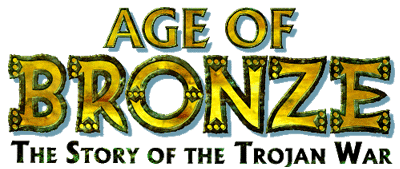
Behold! The Walls of Windy Ilios
A Cartoonist's Adventures in Troy
By Eric Shanower
PART TWO
Back to Part One

Eric Shanower with the South Gate of Troy VI in the background.
The Hisarlık Hotel does provide bars of soap in the rooms, so that's what I used to wash my hair the first two mornings. The third morning I used Woolite. I figured it's gentle enough for fine washables, so it was probably gentle enough for my hair--probably far gentler than the hand soap. Meanwhile, I'd been asking folks where in Tevfikiye, the town next to Troy, I could buy a bottle of shampoo. One of the excavation team took pity and gave me some shampoo. Thanks, Jennie.
Rüstem had told me the first evening that either he or another of the archaeologists might have a little time for me the next morning about 8:30 or 9 am. I was at the entrance to Troy just after eight o'clock, arms, face, and neck coated with spf 50 sunscreen, my camera case over one shoulder, my camcorder case over the other. My daypack with camera tripod sticking out of it was zipped off my backpack and already making my back sweat, my blue baseball cap was clapped to my head, and my sunglasses were parked on my nose. I was all set to go. But the site didn't open to visitors until 8:30. So I waited.
And while I waited I saw a woman approaching leisurely down the drive from the site. As she came closer I began to suspect that she was Liz Riorden. When she spotted me and called "Eric?" I knew it was Liz. She didn't have much time to give me that day--her tour of Troy with me was scheduled for the next day--but she and I walked back across the street to have çay with Mustafa in front of the hotel and chat for a little while.
Mustafa lamented that tourism was down more than 50% this year. The number one reason was fear of avian flu. That surprised me. So many of my friends and family back home had been concerned about the USA's war in Iraq affecting Turkey. No one in Turkey even mentioned the Iraq situation unless I brought it up. They were far more concerned about the situation between Israel and Lebanon. David had been worried before I left that I'd end up in some sort of Midnight Express scenario. I told everyone not to worry, that I could look after myself and that I was taking the phone numbers of the US consulates in Turkey. And actually the most dangerous situation I encountered in Turkey turned out to be one I created myself--trying to climb up the Sigeum Ridge.
Mustafa's talk turned from the fact that the summer weather was several degrees hotter than usual, to Homer's Iliad. He and I began discussing Homer's rivers, the Skamander and the Simoeis, and that inspired me to go seek them that very day. So when Liz returned to Troy I bought a map from Mustafa and set out through the fields north of Troy in search of what was still there to be found from the days of the Late Bronze Age.
The Simoeis river (modern name Dumrek Su) actually paralleled my route as I set out. I could see it quite plainly about half a mile farther north, only I didn't recognize it as a river, not just because in late summer it dwindles to a trickle, but because there was some sort of major dredging project going on. The river was dug up and piles of dirt lined each bank. Only after I'd been told about the dredging was I able to go back and recognize that it was indeed a river.
I tramped for perhaps twenty kilometers that day. Liz had told me to take plenty of water. I thought a bottle and a half was plenty. I was wrong. I munched some butter cookies as I tramped, but the only food I had in my backpack was one power bar. There are no convenience stores out in the countryside around Troy. There are fields of tomatoes, peppers, sunflowers, and Indian corn. It seemed odd to see New World vegetables like tomatoes, peppers, and Indian corn growing in Turkey. The Trojans certainly weren't growing them during the Bronze Age. There were also goatherds with their goats and usually two huge dogs apiece. The dogs were kind of scary when they'd start barking at my approach. I saw chickens around Troy and once a turkey. A turkey in Turkey. Funny to see a New World bird in Asia. The Trojans were famous for their horses, but the only horses I saw were two belonging to a Gypsy camp west of Tevfikiye. Lots of bugs, lots of wildflowers. Lots of frogs in the ditches and fish in the rivers.
I'd wanted to reach the northwestern-most point of the Troad, where the Aegean Sea meets the Hellespont (modern Dardanelles), but there's a Turkish military post there. As I neared the post I came to a small but important-looking red sign sporting words in Turkish. Flipping through my phrase book, I translated one of the words as "forbidden." I turned back.
I reached the Aegean Sea south of the military post and took off my shoes and waded. Yes! The water felt so good after hours of walking. With shoes back on, I started south down the beach. Gradually the beach narrowed until it disappeared. On my right was the sea and on my left was the west face of the Sigeum Ridge.
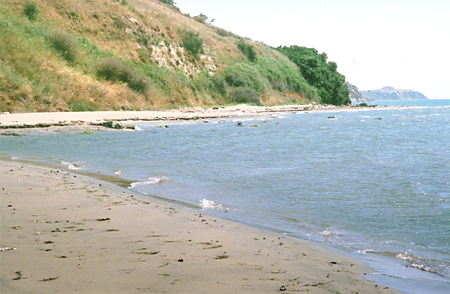
The Aeagean seacoast west of Troy. The Sigeum Ridge rises to the left.
The bump on the headland in the background is Keşik Tepe.
I was tired. The last thing I wanted to do was to retrace my steps all the way back up the beach to where the ridge leveled out. I'd eaten the last of a package of butter cookies hours earlier and drunk most of my water. I guess I wasn't thinking too well because I decided to climb over the ridge. It didn't look that steep from below, so up I started. After maybe ten minutes, hand- and foot-holds became increasingly scarce and precarious. I was actually contemplating trying to climb over a narrow overhang when I finally came to my senses and realized I'd been stupid enough to get myself into a dangerous situation. I decided to climb down. I turned around and saw that getting down would be a lot harder than coming up. The few hand- and foot-holds I'd managed to find seemed to have disappeared when I wasn't looking. With a bit of care and attention, however, I made it safely back to sea-level and began walking back up the beach, cursing my foolhardiness. If I'd fallen, I could've been lying injured for days without anyone finding me. I ate my power bar and drank the last of my water.
The road on the other side of the Sigeum Ridge leads south to the small town of Yenikoy. I needed food and drink and figured I could buy them in town--just under eight kilometers away. I began walking. The tomatoes in the fields I passed grew more and more tempting. But I didn't know whether a Turkish farmer would come after me with a shotgun if I tried to take one. Also, I'd seen people in the fields scattering something over the tomato plants. Pesticide, I guessed. Later I learned that it was sulphur. I kept walking, hoping to see Yenikoy appear over each hill. Every once in a while a vehicle passed. Some of these were trucks full of tomatoes. When I came upon a tomato in the road, obviously fallen from a truck, I picked it up. It wasn't too damaged, so I plunged my fingers beneath the skin, ripped the tomato open, and devoured the juicy, meaty insides. It was delicious. I ate three "roadkill" tomatoes before I reached Yenikoy.
But before Yenikoy I came to Keşik Tepe. This is a hillock, a natural limestone tumulus, on the edge of the ridge above the Aegean Sea nearly due west of Troy. This is where in legend Herakles fought the sea monster to save Priam's sister Hesione, and where the gods on the Achaean side watched the progress of the Trojan War. I climbed to the top for the spectacular view of the cliffs and sea westward and the entire plain of Troy eastward.

The Aegean seacoast looking northward toward the Hellespont from the top of Keşik Tepe.
I rested there for awhile before plunging down the south side of Keşik Tepe and on to Yenikoy at last, where I bought a three-liter bottle of Fanta orange soda, a loaf of bread, and a jar of cherry jam for dinner. Yum.
The sun sank below the horizon behind me as I walked wearily back toward Troy. Just before I reached the Skamander river (modern Kara Menderes), a tractor pulling an open trailer stopped. The two young Turks motioned for me to hop into the trailer, so I rode in field-worker style back to the Hisarlık Hotel.
Every day after that I packed plenty of water.
During my visit to Troy, three people on the archaeological team were kind enough to each give me a tour--Prof. Elizabeth Riorden of the University of Cincinnati, Ohio, architect on Project Troia; Dr. Peter Pavúk of the Department of Archaeology at Comenius University in Bratislava, Slovakia; and Ralf Becks of Tübingen University in Germany. I felt almost unbelievably lucky to be able to tag along as they each explained to me what we were seeing as we looked at piles of stones on a hilltop. I suspect that they were happy to display their knowledge and expertise before an appreciative audience. And I was definitely appreciative, trying to absorb each word they spoke. I'm not sure, though, that I expressed my appreciation well. I didn't want to be too much of a fanboy--though when it comes to Troy, a fanboy is exactly what I am.
After Liz's morning tour among the remains of house walls and citadel fortifications of Troy VI, she left me to wander among the almond trees in the area of Troy VI's Lower City, which remains mostly unexcavated. She didn't want to venture too much into that area again because her legs had just recovered from an allergic reaction to the thistles that cover the Lower City hill. She wasn't just being delicate--I quickly found that it doesn't really matter whether one is wearing long pants or not, the thistles and thorns are gonna getcha. Fortunately, I didn't develop a rash or anything.
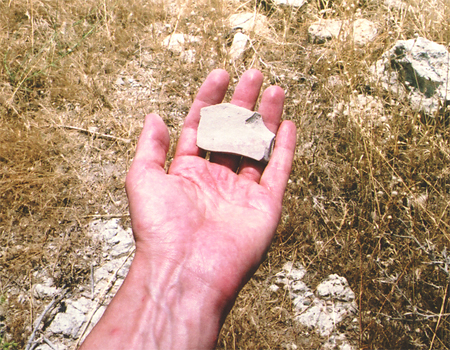
A random potsherd picked up from the Lower City of Troy.
Pieces of broken pottery--sherds--litter the Lower City area. It takes no effort at all to find them. It took me some effort, however, to decide not to try to smuggle one out of Turkey in my luggage. It's against Turkish law to export antiquities without permission. If I'd been caught trying to take ancient pottery from Troy, my tourist visa would have been revoked and I'd never be let into Turkey again--or maybe I'd've ended up in that Midnight Express scenario after all. So I merely picked up some of the sherds to examine, then replaced them. I'm no expert in pottery, so I couldn't date any of the sherds, but some of them had traces of paint. It made me wonder who the person was that had applied those paint strokes. When had that person lived and what was his or her life like?
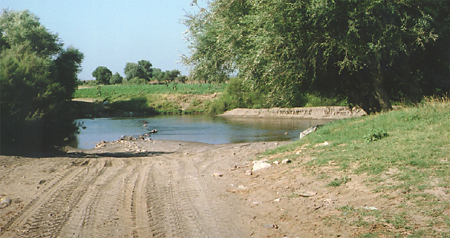
The ford of the Skamander River (Kara Menderes).
My hike the next morning took me to the ford of the Skamander river. In Homer's Iliad Achilles slaughtered so many Trojans at the ford that the river itself rose up to fight him. This was one of the spots in the Troad where it really hit home that the geography of the poem fits the geography of the place. I came away from Troy with the conviction that, whether or not the story of Homer's Iliad ever really happened, Homer himself, whoever he may have been, knew the place well. I'm confident that he spent time there. Others have suggested that Homer need not have ever been to Troy, that someone else who knew the area may simply have fed Homer the information he needed about the place. But I don't agree. Homer was there.
That morning I also looked for the tumulus called Paşa Tepe, Homer's Thorn Hill, where the Trojans form up for their advance in Book 2 of Homer's Iliad. Following the directions in Luce's book, I trekked east of the village of Kalafat south of Troy. On that day I found on the top of a high hill a little mound covered with prickly bushes. It seemed pretty small, but I figured that was Thorn Hill since I could see nothing else around that might do. What I thought was a fig tree stood nearby. Its fruit looked ripe, so I ate one. It was delicious.

I thought the plant-covered mound in the center was Paşa Tepe.
When I described the prickly mound to Liz later that day, she told me that she didn't know what I'd found, but it wasn't Paşa Tepe. I decided to go back the next day to find the real thing.
Sunday was the archaeological team's day off. Liz invited me to the beach along with her colleague, Virginia Russell, a landscape architect from the University of Cincinnati. This was Jennie's first time at Troy, too. She was there to look at how tourists used the site in order to come up with future improvements. Of course, she noticed right away how the wooden horse attracts tourists like a magnet.
One of the first things most tourists at Troy do is climb the stairs to the horse's belly. The ones who remain on the ground seem to be forever snapping photos of their friends or family waving out the windows in the horse's sides. After a few days at Troy I ventured up the stairs into the horse and was even more appalled by the interior than I was by the exterior. There are two sets of stairs, one from the ground to the horse's belly, and the other from the belly into a cabin-like structure on the horse's back. The stairs are very steep, like ladders on a ship, and the tourists carefully inching down them impede the flow of those climbing up. The entries at the tops of the staircases into the belly and into the cabin are just big openings in the floors. Neither is surrounded by railings. One slip could mean major injury, even death. I watched a little child whimpering in fear as one of her parents passed her to the other on the steps as they were exiting the horse's belly.
There are maybe a dozen windows in the whole structure, each with a horizontal shutter which swings open into the interior. Most of the shutters are nailed open, but some of them have come loose, and sharp ends of nails are sticking out, ready to tear clothes and skin--even poke an eye. As I already mentioned, Troy is windy. The horse rocks. And I don't mean rock 'n' roll. I can't believe there isn't at least an injury a week there, if not from the exposed nail-ends, then from someone slipping as he or she struggles to negotiate the stairs. I don't know what kind of insurance the site carries, but I'd think that all it would take is one litigious ugly American getting a splinter and that horse will be shut down. Not that getting rid of the horse would be such a bad thing in my view--kitsch can go too far. But I'd hate to see the site of Troy embroiled in some legal battle.
Jennie wouldn't set foot in the horse. I can't really blame her.
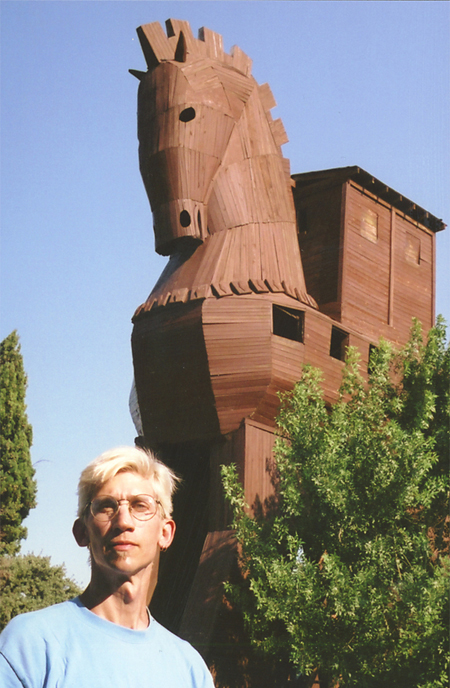
Eric Shanower and the Trojan Horse.
Tourists ask the archaeologists if this horse is the original one.
Liz had rented a car in Çanakkale to drive us to the beach. Liz warned me as we set off that we might end up in a ditch. The rural roads around Troy are no picnic. One, paved with little cement hexagons, bumps along the top of a dike. It's one lane wide. Oncoming traffic could be a problem, except that every so often there's space to pull over and let oncoming vehicles go by. Good thing there's not a lot of traffic, mostly tractors and motorbikes. The unpaved roads are less bumpy--except where there are rocks in the road surface. Passing vehicles raise surprisingly little dust. Maybe the constant wind has already blown the lighter dust away.
The highway to Çanakkale is blacktopped, so driving is smoother, but it's got its own peculiarities. It's generally three lanes wide and there are no markings painted on the road to indicate separate lanes. The outer two lanes are for traffic going in opposite directions, but the middle lane is for passing and it changes every so often between directions of traffic. You have to pay attention to signs on the side of the highway to know whether the middle lane is going your direction or whether it's for oncoming traffic. Maybe the Turks are used to this. I found it a bit hair-raising.
One day while I was at Troy, Peter Jablonka was driving on the highway when a drunk driver struck his car. I didn't see Peter's car afterward, but was told that it was totaled. Peter was taken to the hospital in Çanakkale. Fortunately, he wasn't injured seriously and was back at work at Troy the next day, though I guess he was a little stiff.
Liz didn't have any driving trouble on our beach outing, but the rental car had a few quirks. It had evidently been in an accident in the past. The driver's door was still warped, not so much that you could tell by looking, but the driver's side window didn't fit properly anymore. Whenever Liz lowered or raised it, a horrible grating noise filled the car.
At the beach south of Yenikoy Liz parked. She, Jennie, and I walked over to the sand. To our left the land extended out into the water, ending in a big hump known as Yassi Tepe where there are remains of several occupation levels, one dating to the Late Bronze Age. Spreading before us was the Aegean Sea, several shades of blue, sparkling in the sun. Directly in front were the uninhabited Rabbit Islands. To the south lay Tenedos (Bozcaada), the island where the Achaean ships hid while they waited for the Trojans to drag the wooden horse into Troy.
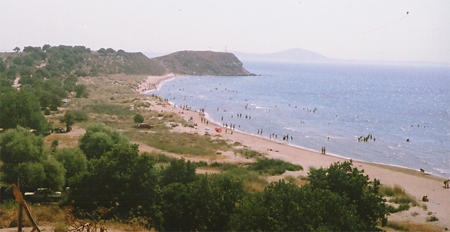
The beach south of Yenikoy. In the center appears the headland known as Yassi Tepe.
Beyond it the island of Tenedos (Bozcaada) floats on the horizon.
I'd brought my swim suit, but wasn't wearing it, so I had to find some bushes to change in. The beach on Sunday afternoon was full of people, and changing out of hiking boots and jeans while trying to not step on any sharp plants or broken branches isn't easy. I may have flashed a few Turkish picnickers.
Soon we were swimming in the Aegean. The water was clear enough so that I could see to avoid stepping on sea urchins. Suddenly it seemed like a miracle that I was there in the same sea that had carried the Achaean army's ships to Troy. A scene I'd drawn of Achilles swimming to shore in Age of Bronze #20 flashed into my mind and I turned toward shore and swam, too.

Achilles swims in the Aegean Sea in Age of Bronze issue 20..
Of course I'd brought my cameras--I took them with me everywhere in Turkey. I set up the camcorder on the tripod and taped a few minutes of me reading aloud. I'd brought a copy of Homer's Iliad, the Lang, Leaf, and Meyers translation--not because I like that translation. I don't, really, but it's the smallest hardcover translation I own--small so that it'd take up as little room as possible in my luggage and hardcover so that it'd stand the stress of being toted all over the Troad in my daypack.
I wasn't aware that the wind was carrying my voice down the beach. Everyone could hear me reading aloud the scene of Achilles on the shore asking his mother to convince Zeus to let the Trojans win for awhile. I guess I was making quite a spectacle of myself. I certainly amused a group of six or seven teenage girls from Çanakkale who began talking to Liz and Jennie. When I returned to my towel, the girls scampered to a safe distance. Jennie thought it was cute and kept telling me that the girls thought I was a movie star. A little later the group of girls waded into the water. All at once I was seeing a living version of the scene in Age of Bronze #6 with the daughters of Lykomedes wading in the Aegean.
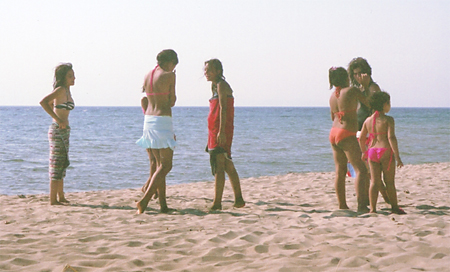
This group of Turkish girls seemed intrigued by the cartoonist from the USA.
Back at the car Jennie and I waited while Liz got in to pull it around. We noticed that the emergency lights were blinking just before Liz started the car. I wondered why, but since the lights went off almost immediately, I figured Liz'd hit the button accidentally. On the next beach north was an excellent fish restaurant where we ate dinner. I ordered a bottle of wine from Bozcaada where there are many vineyards. Liz ordered raki, an anise drink which I tasted. I detest licorice, but this was good. Our table was outside and across from the parking area. Liz noticed that the rental car's emergency lights were blinking. She crossed to the car, but couldn't figure out how to make the blinking stop. Fortunately the Turkish gentleman who takes care of machinery for the archaeologists at Troy was eating at the same restaurant and came to the rescue. Somehow he got the emergency lights to stop flashing.
We drove into Çanakkale to return the rental car. At a stoplight what appeared to be a homeless man leaned in Liz's window, evidently trying to sell her something. He tossed a bag of small, bean-like objects into her lap. She handed it back to him while saying "hayır" (that's "no" in Turkish). A stream of pleading Turkish poured from his mouth. I was in the passenger seat. Liz turned to me with such an alarmed expression that I yelled "hayır!" at the guy. Fortunately the light turned green and Liz took off.
After dropping the car off--I accidentally left my towel in it--we walked along the Çanakkale waterfront and had dessert. It was nearing 11 pm on a Sunday night, but the whole town seemed to be out for an evening stroll to see and be seen. On our way to catch a taxi back to Troy, we had a look at the wooden horse on the waterfront. This horse, a present to the city, is the prop from Wolfgang Peterson's 2004 film Troy, the one that stars Brad Pitt as Achilles. I like it better than the wooden horse at the site. I also like it better than the not-very-well-done model of Troy VI in a glass case right next to the horse on the waterfront.
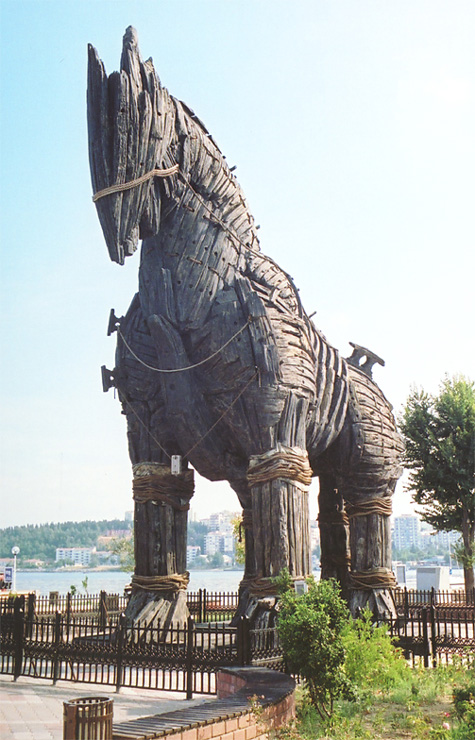
The Wooden Horse from the 2004 film Troy.
Next day I went in search of the real Paşa Tepe and found it. The imposter of the previous day was nearby on a higher hill. The real one, though lower, commands a wider view of the Lower City of Troy and much of the plain. I'd been invited to join the excavation team for lunch, so I went back to what I thought was a fig tree and picked some of the fruit to share. But it seems that my incorrect identification of Paşa Tepe wasn't my only mistake of the previous day. When I arrived at the excavation area and offered my gift, Liz told me that the fruit wasn't figs. She thought they were pears, but even that identification was doubtful. Whatever they were, they tasted delicious.

The real Paşa Tepe.
After locating the real Paşa Tepe, I sat on the bridge over the Çiplak Creek and sketched the Lower City area. A young Turk stopped his truck on the road and called to me. I didn't understand him, only smiled, waved my sketchpad, and called back, "merhaba!" I guess since I didn't seem to be in any trouble, he drove on.
As I crossed the fields toward the Lower City area, I saw what I took to be local farmers crawl under the fence from inside and strike off through the fields. I decided to enter where they'd come out, so I crawled under the barbed wire which had been pulled up and aside to allow free passage. On the east side of the Lower City mound several men were digging in a hole. I figured they were farmers, so I paid them little attention. As I set up my tripod and camcorder to get a shot of Paşa Tepe from the Lower City of Troy, one of the men approached with an air of authority and asked what I was doing. I noticed at once that he wasn't a farmer. I explained who I was. He turned out to be Ralf Becks, another name I recognized from Studia Troica.
Back in the mid-1990s magnetometer readings showed a mysterious line running around the Lower City. Initially thought to show the line of a wall, excavation revealed that it was a ditch--dug into the bedrock--that evidently had surrounded the Bronze Age Lower City of Troy. The day before, I'd jumped down into trenches that had been sunk back in the '90s to confirm the southern point of this Bronze Age defensive ditch. Now Ralf was digging in order to confirm the eastern circuit of the ditch.

This trench with a protective cover over it reveals a Bronze Age ditch
cut into the bedrock south of Troy. The ditch, probably defensive in nature,
indicates the likely southern extent of Bronze Age Troy's Lower City.
A second ditch, further south, has also been discovered.
Later that evening a bunch of us convened to have a few beers and raki at the Priamos Restaurant, the establishment next to the Hisarlik Hotel. Uran runs Priamos, and I highly recommend the eggplant dish he serves with chips (what we in the USA call french fries). I don't recommend the chicken at Uran's: frozen chunks heated in a microwave. Go to Mustafa's next door if you want to eat chicken; it's a better risk there. For one dinner at Mustafa's I got chunks of a better texture than at Uran's, and for another dinner I actually got a real thigh and drumstick that tasted great.
That evening at Uran's I asked Ralf if he'd found anything interesting in the trench he was digging. He said they'd reached Roman levels and were finding pottery. Then a week later on my final evening in Troy, when Ralf was giving me a tour, he revealed that at last they'd been able to sink a shaft below the level of the bedrock, confirming the presence of the ditch on the east side of the Lower City. Here's a preliminary report on the Project Troia website.
Although I'd given up my idea to climb to the summit of Mt. Ida (Kaz Daği), I still wanted to visit the mountains. Liz suggested I visit Ayasma. It's in the mountains, but a shorter trip from Troy and easily accessible. It's a sort of picnic area popular with Turkish people on holiday, but not a place foreign tourists tend to visit. Ayasma is full of springs and waterfalls that feed the Skamander river. In late spring there's a torrent that issues from a cave in a cliff wall. In the story of the Trojan War, these mountains are where Paris grew up, where he and Oenone fell in love, and where he judged the beauty contest among the three goddesses. I'd drawn Paris's childhood home in the first issue of Age of Bronze, but I'm going to need to draw the area again when he visits Oenone once more.
To reach Ayasma I first needed to take a bus to the town of Bayramiç. Liz and Jennie were leaving Troy for Izmir and points farther south the same day I planned to visit Ayasma. That morning the excavation team van dropped us at the highway so that we could flag down buses to our destinations. A gypsy truck was parked next to the fruit stand at the highway. A gypsy girl called "hello" over and over again from the back of the truck. While we waited by the highway, the girl approached, rubbing her fingers together in the international sign for money and repeating "hello." We told her "no" in Turkish--"hayır"--but she wouldn't leave. Maybe she only spoke Romany or something. For a few minutes she just stood next to Jennie, oblivious of our efforts to alternately shoo her and ignore her. Then she began fingering one of Liz's bags. David's undergrad college roommate is Italian. His advice to deal with gypsies is to kick them when they approach. I couldn't bring myself to kick this girl, but I lunged toward her and waved my arms, yelling, "Hey! I'm going to eat you alive!" She fled back to her truck and didn't bother us again.
A bus going Liz and Jennie's way came by first. In a moment they were gone, but I didn't have too long to wait for a bus heading for Bayramiç. Liz had drawn me a map to Ayasma, but Bayramiç was only halfway there, so when the bus dropped me off, I began searching for a dolmus or taxi to take me the rest of the way. I had no clear idea of what to do, but I looked around the bus stop area for a building that had a list of destinations on it.
As I walked along the sidewalk, a man came out of a building and beckoned me inside. He led me to a comfortable-looking office where several other men were sitting. I said "merhaba" all around, sat down in the empty seat indicated for me, and accepted çay. I didn't understand what was going on or what sort of office it was. None of them spoke much English. The first man, now seated behind his desk, knew two English words, "no problem." I pulled out the map that Liz had drawn for me, hoping to make them understand that I wanted to go to Ayasma.
They passed the map around, each of them having a look. They called in another gentleman who also studied the map. I thought the map was pretty self-explanatory, and when I pointed to the word "Ayasma" on it and said that I wanted to go there, I was pretty confident that my motions and inflections would convey the message, even if no one understood my words. The first man kept saying, "no problem," so I sat there and drank my çay, waiting to see what would happen next.
The first man kept handing me copies of his business card. I could read his name: Nihat Ozkaya. And I could even recognize Turkish telephone and fax numbers. But the only other word I could read was the name of the town, Bayramiç. He seemed to place a lot of importance on my understanding his position or job, but I didn't.
Eventually the other men left the office, but still Nihat and I sat there. I had no idea what I was waiting for, whether I was wasting my time or not. At last Nihat ushered me back outside. I thought that maybe he was taking me to a bus or taxi that would take me to Ayasma. We crossed the parking lot where he handed me his card again and pointed to the sign on the front of his office, which had the same words as his card. But they were in Turkish and I just didn't understand them.
We crossed the street and went around the corner. Every so often Nihat would greet another man or group of men. He seemed to know a lot of people in the town. I would smile and try to look as though I knew what was going on. But I didn't. We'd left the bus area. Where were we going? Was he taking me to have a meal?
We went into a building and into a room near the back. There Nihat found a man who spoke German. But that didn't help at all because I don't speak German. So off we went again down the street, Nihat greeting someone every few steps. Into another building and upstairs into a rather plush office. Nihat spoke to someone who hurried off and soon returned with a young attractive woman who spoke some English. Not perfectly fluent, but well enough to act as interpreter.
She asked me some pertinent questions which I did my best to answer. I explained that I wanted to see Ayasma for the day and eat a fresh trout dinner. Liz had suggested the trout. After some back and forth between the woman and me and the woman and Nihat, she explained that Nihat was a very important man, but that he would spend his day showing me Ayasma. I asked, "Kaç para?"--"How much money?"
She translated my question for Nihat and he answered in Turkish. "He says, 'A lot of money,' " she answered, then told me he was only kidding, that it wasn't going to cost anything.
I found that difficult to believe, but I didn't know any other way to get to Ayasma. I decided to go with the flow. I had plenty of New Turkish Lira on me. I hoped it wouldn't cost more than I had.
Nihat led me outside. I thought maybe he'd put me in a taxi now, but, no, he took me back to his office, greeting people along the way. We sat for a few moments, then we climbed into a car parked on the sidewalk just outside. He drove to the back of a nearby building and parked among some buses. I had no idea what was going on. My mind filled with all sorts of scenarios, but everyone in Bayramiç had been courteous, so I remained calm as Nihat got out of the car to move a bus. In a moment he was back. He drove out of the parking lot and through the town, stopping the car every fifty feet or so to greet someone walking by.
At last we made it out of town. I could tell that the car was heading in the direction I wanted to go, but suddenly Nihat pulled off the road. He stopped at a large cement block building that had wide bay doors open along two sides. We got out of the car and he drew me toward the doors, pointing at large empty white tanks inside. I wondered whether this was a trout farm. The tanks didn't have water in them, but maybe these were where they grew the fish?
Several young men in coveralls and white rubber boots were walking here and there. All of a sudden one approached with a plate holding a few long rectangular chunks of some whitish substance. It looked like tofu. Nihat took one of the chunks, bit into it, and motioned for me to do likewise. I did. It was extremely salty cheese!
Nihat was obviously asking whether I liked it. I thought it was too salty, but I didn't want to be insulting, so I nodded and smiled. Nihat had them put some cheese in a bag and we got back in the car and were off once more.
He drove like a maniac. We sped up the single lane road into the mountains, twisting and turning. If we met a truck coming the other way around a curve, we'd be smashed flat. But what could I do? I couldn't ask politely for him to drive slower--I didn't speak his language. I didn't want to insult him by putting on a show of fear at the speed he was driving. I just tried to relax and trust that he knew what he was doing.
In the town of Evciler we stopped again, but this time only Nihat got out. Did he want to greet some folks in this town, too? Maybe so, but he soon returned with a big loaf of bread and we were on our way again.
We certainly were going the right way. Signs along the road announced that Ayasma was ahead. The mountains rose around us. I pointed to a high peak in the distance and asked, "Kaz Daği?" Nihat nodded. Pine forests closed in around us. We passed a mill on a river running on the left. I figured that Ayasma must be pretty close, when all of a sudden a fox crossed the road in front of us and scampered up the side of the hill into the trees. Nihat left the main road and began driving up a dirt path. Was he chasing the fox?
No, we soon arrived at a group of buildings on a slope in the middle of a pine forest. Mountainsides angled steeply upward in every direction. In front of the buildings, large white tanks stood in several rows. But these tanks weren't empty and they weren't for making cheese. Water teeming with fish filled each tank. Men walked along the narrow edges of the tanks, sowing fish food. Carrying the packages he'd collected on the way, Nihat and I got out of the car and walked up the slope to a dining area under a trellis of grape vines. We'd arrived at a trout restaurant.
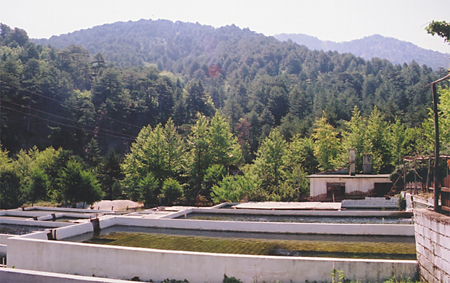
The trout farm in the mountains near Ayasma.
Nihat ordered. While we waited he took me over to the fish tanks where we plunged our hands into the water to catch the little fish, study them for a delightful moment, and then release them. Nihat tapped at the surface of the water that roiled with the larger fish, but I was too timid to put my hand in. It looked as if the fish were trying to bite.
Lunch was fresh trout, tomato salad, salty cheese, bread, beer, and the most delicious green peaches I've ever tasted. The whole meal was excellent. Nihat obviously knew the right place to go. If you ever get to Ayasma, make sure you stop at this restaurant for a trout lunch or dinner:
Name: S. S. Evciler Tarımsal Kalkınma Kooperatifi
Town: Evciler Köyü/Bayramiç
Soğutma Tesisleri Telephone: 793 70 19 (I'd guess this is the number for the restaurant)
Market Telephone: 793 70 84 (I'm not sure what this number is for, but maybe they sell as well as serve fish)
Fax: 793 70 20
Telephone: 793 77 01, 793 77 17 (two more phone numbers, not sure for what, just giving you the information I have)
After the meal, for which I was charged not one lira, Nihat drove us on to Ayasma. How do I describe that place? My first impression was of many levels among the trees, with people grouped around picnic tables and others strolling along the steep paths. Nihat parked the car and guided me among the trees to a world of rocks, leaves, and water. It was gorgeous. Waterfalls plunged to rippling pools. Streams wound between cliffs. Branches sprang from twisted roots to overhang the paths. Leaves cast rippling shadows over everything.
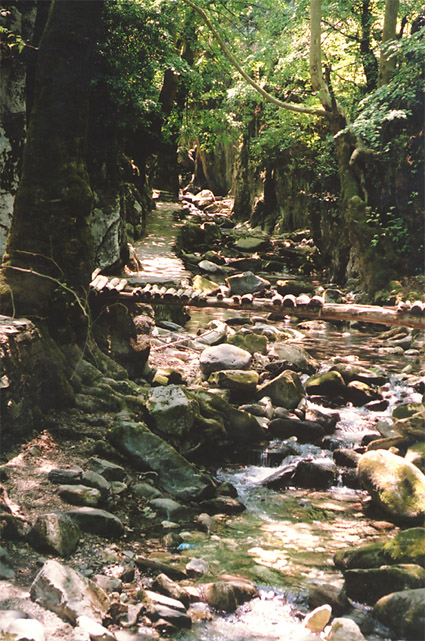
The rocks, trees, and streams of Ayasma.
It was August first, and in late summer the running water had dwindled. Nihat indicated places high on the banks where the water level reaches when the river is full--in spring, I suppose. I was impressed by the beauty of each new view as I followed Nihat up the mountain. He led me to the cave in the cliff-face where a large waterfall bursts forth when the snows are melting higher up. At this point the cave was dry and we could go a little way inside before it grew too narrow. Just the sort of cave Oenone should live in, I thought, at least during the time of year it remains dry.

Nihat Ozkaya stands in front of the cave in the cliff at Ayasma.
Here the torrent issues from the mountain in spring.
We went back down along a different route, one that led steeply downward and across the face of a cliff directly above the river. Nihat was wearing dress shoes, a nice shirt and trousers. He danced along the cliff-face as if it were nothing. I was wearing hiking boots, jeans and a t-shirt, my camera case over one shoulder, my camcorder case over the other, and my daypack on my back, the tripod, as usual, sticking out of the daypack. I could barely find a handhold or foothold on that cliff. I knew it was possible to get across--Nihat had just done it. But I thought I was going to slip and fall backward into the river. I didn't. I made it across that cliff and looked back. Not perfectly sheer, but I couldn't see how I'd done it.
Nihat took me up to a picnic table. He greeted the people there and they served us çay. I pulled out my sketchbook and pencil and began to draw the tall pine trees that rose all around us. This attracted the attention of several families from nearby picnic tables. Soon I was drawing a picture of Nihat. Then the father of a little Turkish girl wanted me to draw his daughter, and I found myself drawing a series of pencil portraits of various people. Nihat went through several more cups of çay while I drew, including cups he'd ordered for me. I was too busy drawing to drink. One woman onlooker was an art teacher, so I sat for her as she sketched a portrait of me. That's the only one I have left since I gave away those I drew to the people who sat for me.
Nihat drove a different route back to Bayramiç, stopping a couple times so that I could take photos of the mountains and the wide river running down from them. Back in his office we sat and had more çay. The young woman who spoke English showed up and explained that Nihat would be driving a bus to Çanakkale and would drop me at the turn-off to Troy. It seems he's in charge of all the public transportation in the area. She also explained that he makes trips to Germany and Romania as, so I gathered, some sort of ambassador to create ties of friendship. I didn't understand completely.
I asked how much I owed for Nihat's services. It had been a wonderful day, and I was certainly willing to pay a fair price for all Nihat had done for me. Again she told me there was no charge. And there wasn't. She explained that Nihat liked me very much and wanted to demonstrate the hospitality of Turkey. I tried to accept that as the explanation, but as someone from the USA, the land of commercialism, competition, and consumption, it was difficult, especially because I couldn't think of a way to repay him for all he'd done. Telling you, the person reading this right now, the story of my experience to show how generous, kind, and warm the Turks can be is the only way I can think of to try to do Nihat a favor in return, at least for now.
Just before 5:30 the three of us left Nihat's office. I thanked the young woman, Binnur, for her help and followed Nihat onto the bus. He took the driver's seat, and I sat right behind him. When the steward came by to collect fares, Nihat told him that I was his guest. Complimentary to the very end. As I exited the bus at the turn-off to Troy, I burbled all the words I could remember in Turkish for "thank you." The one that really made Nihat smile was "arkadaş," the Turkish word for "friend."
Part Three
Copyright © 2006 Eric Shanower. All rights reserved.
|
|
|
Home |
Issues |
Books |
T-shirts |
Blog |
Pronunciations |
Our Story So Far
Free Features |
Store |
Privacy |
Links |
Archives
Eric Shanower |
Hungry Tiger Press
All materials are Copyright © 2000, 2001, 2002, 2003, 2004, 2005, 2006, 2007, 2008, 2009, 2010, 2011, 2012, 2013, 2014, 2015, 2016, 2017, 2018, 2019, 2020, 2021, 2022, 2023 Eric Shanower. All rights reserved.
The Age of Bronze logo and all prominent characters and their likenesses are trademarks of Eric Shanower.
Image "i" logo is TM and copyright © 1992-2023 Image Comics, Inc.
No portion of this website may be used by generative artificial intelligence without written permission.
Website designed by Digital Sourcery
Contact Webmaster
Contact Eric Shanower
|

|
|
|

